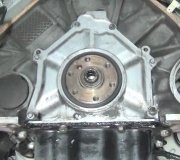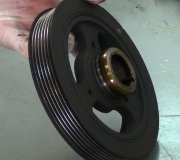A way around replacing the crank could be a speedi sleeve if they make one in the correct size. Basically a thin stainless sleeve that is pressed and glued over the worn area of the crankshaft to increase it's size and remove the wear spots. Where I have run into rear main leaks past this type of seal was when an engine had been rebuilt and the folks who ground the crankshaft got a bit carried away and went to the maximum undersize. The OE seals in those would barely touch the seal surface on the crankshaft and you would get leaks in the areas that didn't have enough crush to make the seal. The old trick for that was to add a shim behind the seal to push it tighter against the crankshaft area. You apply a thin smear of permatex #2 to the shim and install it, then the seal section, then repeat on the main cap, apply the sealer to the specified areas and bolt it into place.
I've also seen the new "replacement" seals be made wrong, ran into that on a few small blocks with the early one piece seal. The seals were made with excess tolerance and would leak after about a week of running.
Perhaps have the mechanic try a test, with the current seal in there, clean off everything real well with some cleaner, now dust the area with baby powder or similar. Start the engine and see where the oil darkens the powder first. If it's at one of the parting lines then it could be a lack of sealant or the seal isn't seating correct. If it instead shows up at the seal lip where it rides on the crankshaft it is likely the seal isn't correct or the crankshaft has been ground so the seal no longer functions.
Lastly would be if the main bearings are worn in excess. That can cause the crankshaft to walk in the bearings and distort the seal enough that it can leak almost instantly because of that, it is more common with a manual transmission for the reasons stated above, a quick check of them using plastigauge would show that as well as any taper. Even looking on the rear main for it's size might help.
Thursday, August 12th, 2021 AT 4:00 PM





